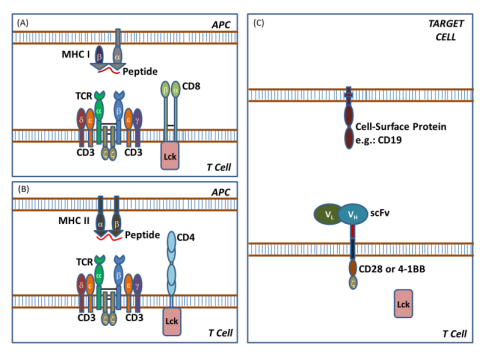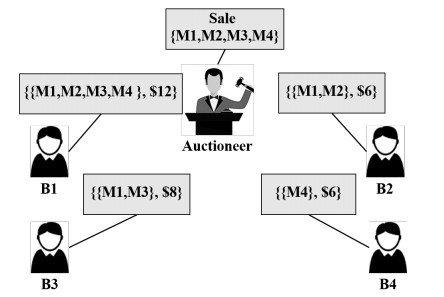|
[1]
|
S. J. Rassenti, V. L. Smith, R. L. Bulfin, A combinatorial auction mechanism for airport time slot allocation, Bell J. Econ., 13 (1982), 402–417. https://doi.org/10.2307/3003463 doi: 10.2307/3003463

|
|
[2]
|
K. Xu, Y. Zhang, X. Shi, H. Wang, Y. Wang, M. Shen, Online combinatorial double auction for mobile cloud computing markets, in IEEE 33rd International Performance Computing and Communications Conference, (2014), 1–8. https://doi.org/10.1109/PCCC.2014.7017103
|
|
[3]
|
T. G. Chetan, M. Jenamani, S. P. Sarmah, Two-stage multi-attribute auction mechanism for price discovery and winner determination, Trans. Eng. Manage., 66 (2019), 112–126. https://doi.org/10.1109/TEM.2018.2810510 doi: 10.1109/TEM.2018.2810510

|
|
[4]
|
S. Wang, S. Qu, M. Goh, M. Wahab, H. Zhou, Integrated multi-stage decision-making for winner determination problem in online multi-attribute reverse auctions under uncertainty, Int. J. Fuzzy Syst., 22 (2019), 2354–2372. https://doi.org/10.1007/s40815-019-00757-0 doi: 10.1007/s40815-019-00757-0

|
|
[5]
|
W. Fontanini, P. A. Ferreira, A game-theoretic approach for the web services scheduling problem, Expert Syst. Appl., 41 (2014), 4743–4751. https://doi.org/10.1016/j.eswa.2014.02.016 doi: 10.1016/j.eswa.2014.02.016

|
|
[6]
|
D. H. Kim, S. A. Kazmi, A. Ndikumana, A. Manzoor, W. Saad, C. S. Hong, et al., Distributed radio slice allocation in wireless network virtualization: matching theory meets auctions, IEEE Access, 8 (2020), 494–732. https://doi.org/10.1109/ACCESS.2020.2987753 doi: 10.1109/ACCESS.2020.2987753

|
|
[7]
|
A. K. Ray, M. Jenamani, P. K. Mohapatra, Supplier behavior modeling and winner determination using parallel mdp, Expert Syst. Appl., 38 (2011), 4689–4697. https://doi.org/10.1016/j.eswa.2010.08.044 doi: 10.1016/j.eswa.2010.08.044

|
|
[8]
|
S. De Vries, R. V. Vohra, Combinatorial auctions: a survey, INFORMS J. Comput., 15 (2003), 284–309. https://doi.org/10.1287/ijoc.15.3.284.16077 doi: 10.1287/ijoc.15.3.284.16077

|
|
[9]
|
M. Rekik, S. Mellouli, Reputation-based winner determination problem for combinatorial transportation procurement auctions, J. Oper. Res. Soc., 63 (2012), 1400–1409. https://doi.org/10.1057/jors.2011.108 doi: 10.1057/jors.2011.108

|
|
[10]
|
W. Zhong, K. Xie, Y. Liu, C. Yang, S. Xie, Multi-resource allocation of shared energy storage: a distributed combinatorial auction approach, IEEE Trans. Smart Grid, 11 (2020), 4105–4115. https://doi.org/10.1109/TSG.2020.2986468 doi: 10.1109/TSG.2020.2986468

|
|
[11]
|
M. H. Rothkopf, A. Pekeč, R. M. Harstad, Computationally manageable combinational auctions, Manag. Sci., 44 (1998), 1131–1147. https://doi.org/10.1287/mnsc.44.8.1131 doi: 10.1287/mnsc.44.8.1131

|
|
[12]
|
X. Li, S. Ma, Multi-objective memetic search algorithm for multi-objective permutation flow shop scheduling problem, IEEE Access, 4 (2016), 2154–2165. https://doi.org/10.1109/ACCESS.2016.2565622 doi: 10.1109/ACCESS.2016.2565622

|
|
[13]
|
Z. Lu, Y. Zhou, J. K. Hao, A hybrid evolutionary algorithm for the clique partitioning problem, IEEE Trans. Cybernetics, (2021).
|
|
[14]
|
M. Aïder, O. Gacem, M. Hifi, A hybrid population-based algorithm for the bi-objective quadratic multiple knapsack problem, Expert Syst. Appl., 191 (2022), 116238. https://doi.org/10.1016/j.eswa.2021.116238 doi: 10.1016/j.eswa.2021.116238

|
|
[15]
|
Q. Zhou, J. K. Hao, Q. Wu, A hybrid evolutionary search for the generalized quadratic multiple knapsack problem, Eur. J. Oper. Res., 296 (2022), 88–803. https://doi.org/10.1016/j.ejor.2021.04.001 doi: 10.1016/j.ejor.2021.04.001

|
|
[16]
|
X. Li, X. Zhang, M. Yin, J. Wang, A genetic algorithm for the distributed assembly permutation flowshop scheduling problem, in 2015 IEEE Congress on Evolutionary Computation (CEC), (2015), 3096–3101. https://doi.org/10.1109/CEC.2015.7257275
|
|
[17]
|
Y. Zhou, X. Liu, S. Hu, Y. Wang, M. Yin, Combining max-min ant system with effective local search for solving the maximum set k-covering problem, Knowl. Based Syst., 239 (2021), 108000. https://doi.org/10.1016/j.knosys.2021.108000 doi: 10.1016/j.knosys.2021.108000

|
|
[18]
|
Ș. Öztürk, R. Ahmad, N. Akhtar, Variants of artificial bee colony algorithm and its applications in medical image processing, Appl. Soft Comput., 97 (2020), 106799. https://doi.org/10.1016/j.asoc.2020.106799 doi: 10.1016/j.asoc.2020.106799

|
|
[19]
|
M. Dorigo, L. M. Gambardella, Ant colony system: a cooperative learning approach to the traveling salesman problem, IEEE Trans. Evol. Comput., 1 (1997), 53–66. https://doi.org/10.1109/4235.585892 doi: 10.1109/4235.585892

|
|
[20]
|
X. Zhang, X. Li, J. Wang, Local search algorithm with path relinking for single batch-processing machine scheduling problem, Neural Comput. Appl., 28 (2017), 313–326. https://doi.org/10.1007/s00521-016-2339-z doi: 10.1007/s00521-016-2339-z

|
|
[21]
|
M. Li, J. K. Hao, Q. Wu, Learning-driven feasible and infeasible tabu search for airport gate assignment, Eur. J. Oper. Res., 2021 (2021). https://doi.org/10.1016/j.ejor.2021.12.019 doi: 10.1016/j.ejor.2021.12.019

|
|
[22]
|
Z. Lu, J. K. Hao, U. Benlic, D. Lesaint, Iterated multilevel simulated annealing for large-scale graph conductance minimization, Inform. Sci., 572 (2021), 182–199. https://doi.org/10.1016/j.ins.2021.04.102 doi: 10.1016/j.ins.2021.04.102

|
|
[23]
|
F. Glover, Tabu search-part i, ORSA J. Comput., 1 (1989), 190–206. https://doi.org/10.1287/ijoc.1.3.190 doi: 10.1287/ijoc.1.3.190

|
|
[24]
|
Y. Zhou, J. Li, Y. Liu, S. Lv, Y. Lai, J. Wang, Improved memetic algorithm for solving the minimum weight vertex independent dominating set, Mathematics, 8 (2020), 1155. https://doi.org/10.3390/math8071155 doi: 10.3390/math8071155

|
|
[25]
|
P. V. Silvestrin, M. Ritt, An iterated tabu search for the multi-compartment vehicle routing problem, Comput. & Oper. Res., 81 (2017), 192–202. https://doi.org/10.1016/j.cor.2016.12.023 doi: 10.1016/j.cor.2016.12.023

|
|
[26]
|
L. Xing, Y. Liu, H. Li, C. C. Wu, W. C. Lin, X. Chen, A novel tabu search algorithm for multi-agv routing problem, Mathematics, 8 (2020), 279. https://doi.org/10.3390/math8020279 doi: 10.3390/math8020279

|
|
[27]
|
B. Vangerven, D. R. Goossens, F. C. Spieksma, Winner determination in geometrical combinatorial auctions, Eur. J. Oper. Res., 258 (2017), 254–263. https://doi.org/10.1016/j.ejor.2016.08.037 doi: 10.1016/j.ejor.2016.08.037

|
|
[28]
|
M. Kaleta, Network winner determination problem, Arch. Control Sci., 28 (2018). https://doi.org/10.24425/119077 doi: 10.24425/119077

|
|
[29]
|
N. Remli, A. Amrouss, I. El Hallaoui, M. Rekik, A robust optimization approach for the winner determination problem with uncertainty on shipment volumes and carriers' capacity, Trans. Res. Part B: Meth., 123 (2019), 127–148. https://doi.org/10.1016/j.trb.2019.03.017 doi: 10.1016/j.trb.2019.03.017

|
|
[30]
|
X. Qian, S. C. Fang, M. Huang, X. Wang, Winner determination of loss-averse buyers with incomplete information in multiattribute reverse auctions for clean energy device procurement, Energy, 177 (2019), 276–292. https://doi.org/10.1016/j.energy.2019.04.072 doi: 10.1016/j.energy.2019.04.072

|
|
[31]
|
X. Qian, F. T. Chan, M. Yin, Q. Zhang, M. Huang, X. Fu, A two-stage stochastic winner determination model integrating a hybrid mitigation strategy for transportation service procurement auctions, Comput. Ind. Eng., 149 (2020), 106703. https://doi.org/10.1016/j.cie.2020.106703 doi: 10.1016/j.cie.2020.106703

|
|
[32]
|
C. W. Lee, W. P. Wong, J. Ignatius, A. Rahman, M. L. Tseng, Winner determination problem in multiple automated guided vehicle considering cost and flexibility, Comput. Ind. Eng., 142 (2020), 106337. https://doi.org/10.1016/j.cie.2020.106337 doi: 10.1016/j.cie.2020.106337

|
|
[33]
|
Y. Fujishima, K. Leyton-Brown, Y. Shoham, Taming the computational complexity of combinatorial auctions: Optimal and approximate approaches, in IJCAI, 99 (1999), 548–553.
|
|
[34]
|
N. Nisan, Bidding and allocation in combinatorial auctions, in Proceedings of the 2nd ACM Conference on Electronic Commerce, (2000), 1–12. https://doi.org/10.1145/352871.352872
|
|
[35]
|
K. Leyton-Brown, Y. Shoham, M. Tennenholtz, An algorithm for multi-unit combinatorial auctions, in Aaai/iaai, (2000), 56–61.
|
|
[36]
|
T. Sandholm, S. Suri, Bob: Improved winner determination in combinatorial auctions and generalizations, Artif. Intell., 145 (2003), 33–58. https://doi.org/10.1016/S0004-3702(03)00015-8 doi: 10.1016/S0004-3702(03)00015-8

|
|
[37]
|
O. Günlük, L. Ladányi, S. De Vries, A branch-and-price algorithm and new test problems for spectrum auctions, Manag. Sci., 51 (2005), 391–406. https://doi.org/10.1287/mnsc.1040.0332 doi: 10.1287/mnsc.1040.0332

|
|
[38]
|
L. F. Escudero, M. Landete, A. Marín, A branch-and-cut algorithm for the winner determination problem, Decis. Support Syst., 46 (2009), 649–659. https://doi.org/10.1016/j.dss.2008.10.009 doi: 10.1016/j.dss.2008.10.009

|
|
[39]
|
H. H. Hoos, C. Boutilier, Solving combinatorial auctions using stochastic local search, in Aaai/iaai, (2000), 22–29.
|
|
[40]
|
Y. Guo, A. Lim, B. Rodrigues, Y. Zhu, Heuristics for a bidding problem, Comput. Oper. Res., 33 (2006), 2179–2188.
|
|
[41]
|
D. Boughaci, B. Benhamou, H. Drias, Stochastic local search for the optimal winner determination problem in combinatorial auctions, in International Conference on Principles and Practice of Constraint Programming, Springer, (2008), 593–597.
|
|
[42]
|
N. Wang, D. Wang, Model and algorithm of winner determination problem in multi-item e-procurement with variable quantities, in The 26th Chinese Control and Decision Conference (2014 CCDC), (2014), 5364–5367. https://doi.org/10.1109/CCDC.2014.6852222
|
|
[43]
|
M. B. Dowlatshahi, V. Derhami, Winner determination in combinatorial auctions using hybrid ant colony optimization and multi-neighborhood local search, J. AI Data Min., 5 (2017), 169–181.
|
|
[44]
|
D. Boughaci, B. Benhamou, H. Drias, A memetic algorithm for the optimal winner determination problem, Soft Comput., 13 (2009), 905. https://doi.org/10.1007/s00500-008-0355-3 doi: 10.1007/s00500-008-0355-3

|
|
[45]
|
H. Zhang, S. Cai, C. Luo, M. Yin, An efficient local search algorithm for the winner determination problem, J. Heuristics, 23 (2017), 367–396. https://doi.org/10.1007/s10732-017-9344-y doi: 10.1007/s10732-017-9344-y

|
|
[46]
|
G. Lin, W. Zhu, M. M. Ali, An effective discrete dynamic convexized method for solving the winner determination problem, J. Comb. Optim., 32 (2016), 563–593. https://doi.org/10.1007/s10878-015-9883-9 doi: 10.1007/s10878-015-9883-9

|
|
[47]
|
G. Lin, Z. Li, A hybrid binary harmony search algorithm for solving the winner determination problem, Int. J. Innovative Comput. Appl., 10 (2019), 59–68. https://doi.org/10.1504/IJICA.2019.100547 doi: 10.1504/IJICA.2019.100547

|
|
[48]
|
H. C. Lau, Y. G. Goh, An intelligent brokering system to support multi-agent web-based 4/sup th/-party logistics, in 14th IEEE International Conference on Tools with Artificial Intelligence, (2002), 154–161.
|
|
[49]
|
K. Leyton-Brown, M. Pearson, Y. Shoham, Towards a universal test suite for combinatorial auction algorithms, in Proceedings of the 2nd ACM Conference on Electronic Commerce, (2000), 66–76. https://doi.org/10.1145/352871.352879
|
|
[50]
|
M. López-Ibáñez, J. Dubois-Lacoste, L. P. Cáceres, M. Birattari, and T. Stützle, The irace package: Iterated racing for automatic algorithm configuration, Oper. Res. Perspect., 3 (2016), 43–58. https://doi.org/10.1016/j.orp.2016.09.002 doi: 10.1016/j.orp.2016.09.002

|










 DownLoad:
DownLoad: 




